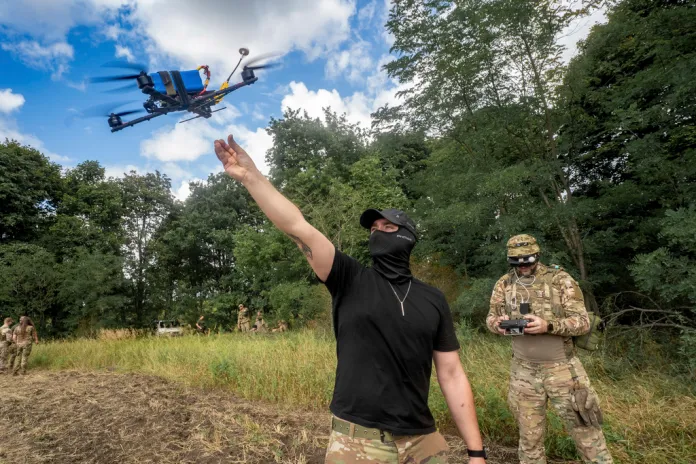


The U.S. Army selected the drone company Draganfly to supply first-person view drones, weapons that have proven decisive in the war in Ukraine.
One of the largest conventional wars since World War II has upended the art of war, with Russia and Ukraine rapidly innovating in an effort to get the upper hand. The single most decisive weapon to emerge from the war is the FPV drone, a kamikaze drone with armor-piercing or antipersonnel warheads that allows an operator to pilot it straight into enemy vehicles and personnel. Militaries around the world are scrambling to adopt the new technology, including the United States.
Recommended Stories
- Ben of Ben & Jerry’s chainsaws mini Pentagon on Capitol Hill
- Trump says he told Hegseth military should use US cities as 'training grounds'
- Hegseth pledges to reshape War Department after ‘decades of decay’

The Army announced the awarding of the vital contract to Draganfly on Tuesday, a major step in integrating FPV drones into the U.S. military.
“We are honored to support the U.S. Army as it moves critical drone capabilities closer to front lines,” Cameron Chell, president and CEO of Draganfly, said in a statement. “By combining advanced Flex FPV Drone systems, embedded manufacturing, training and secure logistics, we are helping reinforce operational agility and sustainment for forward-deployed forces. This helps ensure personnel have the tools, training and capabilities required when and where they need them most.”
As part of the contract, Draganfly will deliver Flex FPV drones to combat units and establish manufacturing sites within U.S. bases to shorten supply lines.
Draganfly will also provide operating and manufacturing training to military personnel.
The company has recently begun producing military-grade FPV drones in response to growing demand, having previously spearheaded innovation in agriculture, industrial inspections, mapping, surveying, security, and public safety, according to a press release.
Following the success of FPV drones in Ukraine, the U.S. has begun trying to incorporate the drones into U.S. Army units during exercises. During the Swift Response 2025 exercise in Lithuania, U.S. paratroopers used FPV drones against man- and vehicle-sized moving targets.
The U.S. Army made history in August at the U.S. Army’s Unmanned Aerial Systems and Launched Effects Summit at Fort Rucker, Alabama, when U.S. paratroopers carried out the first-ever drone-on-drone strike during a live-fire exercise.
“We must safely conduct training, testing, and experimentation,” 1st Lt. Francesco La Torre, who achieved the milestone, said at the time. “We also must make sure everything we do is exportable to other units so they can do the same. I’m confident what we’ve done is scalable, and the Lethal UAS Course at Fort Rucker will centralize the growth of lethal UAS engagements while also serving as a hub for subject matter experts to gather and exchange lessons learned.”
The success and ascendancy of the cheap FPV drones came as a surprise to many analysts. In the Second Nagorno-Karabakh War between Armenia and Azerbaijan in 2020, the first war that saw the truly decisive use of drones, the two most decisive drones were the expensive Bayraktar and IAI Harop kamikaze drone, which cost roughly $10 million per unit.
LAWMAKERS WARNED OF RISING SECURITY THREATS FROM DRONES DURING HOUSE HEARING
The Bayraktar, which operates like the famous U.S. MQ-9 Reaper drone, was effective in the initial days of the Russia-Ukraine war, but all units were soon shot down as Russia adapted. The mass use of drones soon shifted to quadcopters, which were rigged to drop single grenades on soldiers. This evolved into the FPV drones, which could carry heavier and armor-piercing payloads. Effective, cheap, and able to be mass-produced, the drones have changed the face of warfare.
Thousands, if not tens of thousands, of videos of FPV drones hunting and killing tanks, vehicles of all kinds, and soldiers, have flooded social media since mid-2023. The FPV drone revolution has led some analysts to believe that the massing of troops and armored vehicles may become obsolete, with the future of war decided by who can best mass and deploy swarms of FPV and other drones.
